|
For its entire life as a trout stream, the Rio Grande is such a place. It is
a throwback to a different era of fly fishing where each moment spent
angling offers more delights than the opportunity to catch a fish. It is a
demanding river, rugged and wild, holding challenging trout that, if you
can find them, will chomp your fly, bust the surface with a colossal jump,
startle you with the speed with which they swim upstream, then shred
your leader on a submerged rock and be gone.
The Rio Grande - simply "Big River" in spanish - is the unsung giant
among American rivers. The second-longest river in the United States,
flowing 1,885 miles from headwaters to the sea, is a river of mystery,
virtually unknown to the world outside its drainage. What fleeting image
the river does have in the consciousness of America is a false impression
painted in black and white. Countless double-reel westerns pumped from
Hollywood like slugs from a six-shooter, portrayed dusty cowboys reaching
across a parched plain for a trickle of water they called the Rio Grande.
The lower two-thirds of the Rio Grande is indeed such a desert stream.
But the top third of the river is another world, one of summer snowfields,
aspens and firs, and a spectacular gorge dropping abruptly from
sage-brush hills.[See map,
click here.]
Rising at the Continental Divide deep within the San Juan Mountains of
southern Colorado, the Rio Grande begins its journey as a quintessential
mountain stream, tumbling through meadows riotious with wildflowers
against a backdrop of bald peaks. Escaping from the mountains, the river
flows for 70 miles across the tortilla-flat San Luis Valley. In this extensive
basin, larger than the combined area of several New England states, the
featureless meanders of the river are too warm for trout. Only after entering
New Mexico and carving a sinuous gorge that divides the northern half of
the state in two does the river again support coldwater species.
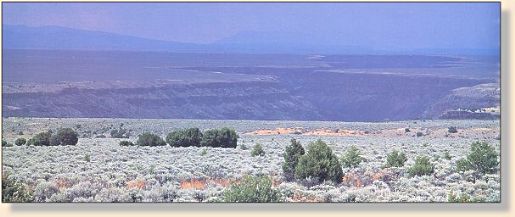
Exiting the broad valley between the Sangre de Cristo and San Juan
ranges, the mountain of the Rio Grande disappears twenty miles north of
Santa Fe where the muddy Rio Chama enters from the west. South of
Sante Fe, flood control and irrigation dams alter the nature of the river
and its riparian vegetation.
The Anasazi culture built multi-storied stone and adobe pueblos
along the Rio Grande beginning in the thirteenth century. Evidence
of their long use of the land can be found in thousands of petroglyphs
pecked into the black basalt within the river's canyons. Spanish
conquistadors in search of gold and souls to save arrived on the Rio
Grande in 1540, long before the settlements along the Atlantic
seaboard were established. The first European colony on the Rio
Grande was founded in 1598 near the river's confluence with the
Rio Chama.
In the early days of european settlement, the Rio Grande suffered from
an identy crisis. Spanish explorers encountering the river at different
locations failed to see it as a single stream and attached no less than
twelve names to its waters. As the geography of New Mexico and
Texas was gradually sorted out, the river became known as the Rio
del Norte, the River of the North, and the Rio Bravo, Bold River.
After the conquest of New Mexico in 1846, American map makers
gave the river its current name, but in Mexico it is still called the Rio
Bravo.
The Rio Grande in Colorado
In Colorado, the Rio Grande is surrounded by an extensive wilderness.
Less than 500 people live within the over 650 square miles of the watershed
above Creede. This quiet forest rimmed in 13,000-foot peaks is isolated,
far removed from the nearest big cities of Denver and Albuquerque, each
over 300 miles away.
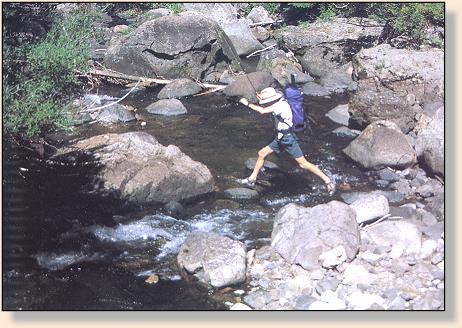
The anglers who love to fish a varity of waters will find it all on the Rio
Grande. You can fish the river for a week and enjoy a different type of
angling experience, from small streams to wide flats, every day. Hike-in
water is plentiful in canyons, and drive-up, cast-from-your-car water is
here, too. The connected valleys below Creede are big water, perfect
for floating. With almost perfect habitat, and abundant food base, and
a remote location, the upper river is a consistent producer of large trout.
Not all fishermen come away pleased with the Rio Grande, but skilled and
patient anglers will quickly fall under the river's spell.
Headwaters of the Rio Grande
On midsummer mornings, water temperatures hover in the upper fourties
and the trout are lethargic. Around 11 A.M. mayflies and yellow stoneflies
start to come off the water and the browns, brookies, and cutthroats begin
feeding. They are fussier than most high-country trout, but take with
confidence imitations that suit their fancy. Size 12 to 18 parachute
mayfly imitation in brown, tan, gray, and yellow are perfect for this
rippling water, with a few small hopper patterns thrown in for good measure.
You'll find beautiful brook trout up to 12 inches and the potential for
browns up to 14 inches. [For the flies,
click here.]
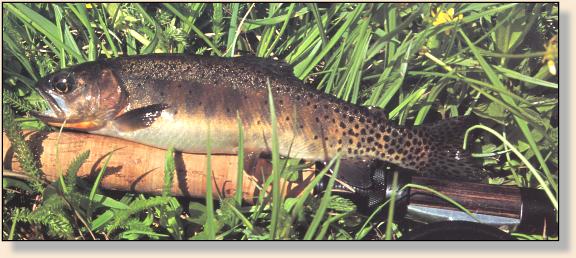
Not only does the upper Rio Grande offer quality fly fishing admid grand
scenery, but the river's headwater tributaries do as well. Creeks draining
the glacial valleys surrounding the river hold brook, brown and cutthroat
trout up to 14 inches. Small rods, bushy flies, and stalking techniques are
required to take fish in the pocket water and meadows of the creeks. With
excellent trails leading along most of the streams, they tempt you with the
promise of solitary backpacking trips into remote country.
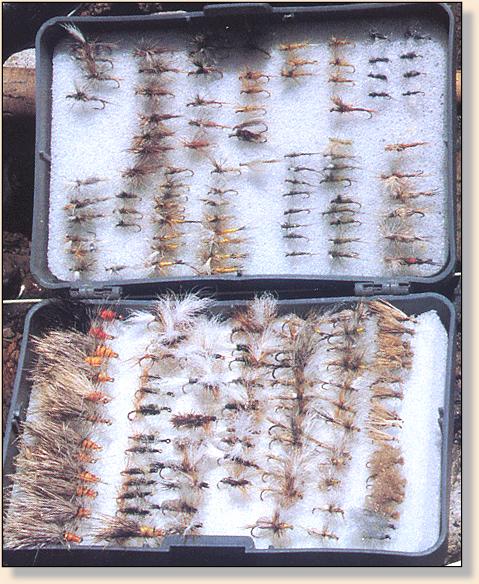
From bottom to top, the Rio Grande flows through six major canyons.
Three vertical-walled desert canyons - Boquillas, San Marical, and Santa
Elena - nip at each others heels as the river arcs through half a circle at
Big Bend along the Texas-Mexico border. It's a thousand miles upstream
to White Rock Canyon where the river slices through the Cerros del Rio
volcanic field, followed by the long gorge through the Taos Plateau. In
Colorado, only Box Canyon and the impossible cataracts of the headwaters
throw the river and its fish into seclusion.
The Creede Area
Brown trout remain the heart of the Creede area fishery. Possession and
slot limits were instituted when the rainbows were introduced, and the brown
population thrives. They average from 12 to 14 inches and larger fish are
common.
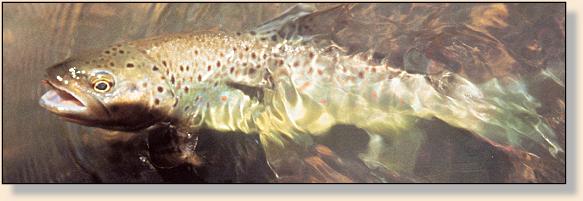
Special regulations apply from the Rio Grande Fisherman Access Area to
Marshall Park Campgrounds and from Willow Creek to Goose Creek.
Angling is restricted to flies and lures only. The water is catch-and-release
for all rainbows, and a two-fish bag and possession limit for brown trout
is in effect. The browns must be 12 inches or shorter.
Timing is important here. The river can be floated only during the high flows
associated with runoff. However, during early runoff, from May to mid-June
water temperatures are too cold for insect activity and angling is poor. Warming
temperatures in mid-June stimulate insect activity, and thus trout feeding.
Conditions for floating are usually ideal from mid-to late June and through late
July, depending on winter snow-pack. By August, low flows make floating
impossible.
Gold Medal Water
 In recognition of the fine habitat, abundant food supply and versatile angling
potential, the section of the Rio Grande between South Fork and Del Norte
has been designated by the Colorado Division of Wildlife as Gold Medal
Water. . . From the upper boundary of the Gold Medal Water at the Highway
149 bridge to the Rio Grande Canal diversion structure, angling is limited to
artificial flies or lures only. A two-fish, 16 inches or longer limit is in effect
for browns, and all rainbow trout must be immediately returned to the water.
In recognition of the fine habitat, abundant food supply and versatile angling
potential, the section of the Rio Grande between South Fork and Del Norte
has been designated by the Colorado Division of Wildlife as Gold Medal
Water. . . From the upper boundary of the Gold Medal Water at the Highway
149 bridge to the Rio Grande Canal diversion structure, angling is limited to
artificial flies or lures only. A two-fish, 16 inches or longer limit is in effect
for browns, and all rainbow trout must be immediately returned to the water.
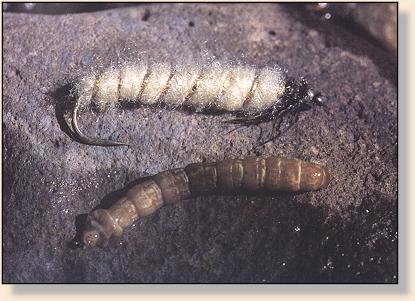
The Gold Medal Water assuredly deserves its lasting reputation as a quality
brown trout fishery. The size and numbers of trout in this stretch of the
Rio Grande are exceptional. Wild browns predominate, with thousands
of fish in 12 - 14-inch class in every mile of river and many fish up to
18 inches. Wild rainbows are similar in size but less common, and a few
cutbow hybrids up to 18 inches are also found here. The fish are well-fed,
healthy, smart and strong - everything wild trout should be.
The finest fly fishing rivers offer a wide diversity of angling experience, with
every reach seeming like a distinct smaller stream. The Rio Grande's scenic
headwaters, rugged canyons, and broad, floatable stretches hold up well
against other rivers widely accepted as premier angling destinations.
Although it remains a well-kept secret, the Rio Grande offers all the features
of the best streams in the West.
As the sport of fly fishing becomes more popular, it is increasingly difficult
to find a stretch of river to call your own, if only for a few hours. The beauty
of the Rio Grande, both in the San Juans and in the Gorge, lies in its endless,
uncrowded miles of trout habitat. Although short stretches of the river
receive heavy use, it is unlikely that the headwaters or the canyons of the
Rio Grande will ever see more than a few fishermen. Anglers who are
looking for the opportunity to experience a forgotten type of fly fishing
owe it to themselves to give the Rio Grande a try. ~ Craig Martin

For a map of The Rio Grande River, click here.
For the flies for The Rio Grande River, click here.
To ORDER Rio Grande River direct from the publisher, click
HERE.
Credits: From Rio Grande part of the River Journal
series, published by Frank Amato Publications.
We greatly appreciate use permission.
|







 In recognition of the fine habitat, abundant food supply and versatile angling
potential, the section of the Rio Grande between South Fork and Del Norte
has been designated by the Colorado Division of Wildlife as Gold Medal
Water. . . From the upper boundary of the Gold Medal Water at the Highway
149 bridge to the Rio Grande Canal diversion structure, angling is limited to
artificial flies or lures only. A two-fish, 16 inches or longer limit is in effect
for browns, and all rainbow trout must be immediately returned to the water.
In recognition of the fine habitat, abundant food supply and versatile angling
potential, the section of the Rio Grande between South Fork and Del Norte
has been designated by the Colorado Division of Wildlife as Gold Medal
Water. . . From the upper boundary of the Gold Medal Water at the Highway
149 bridge to the Rio Grande Canal diversion structure, angling is limited to
artificial flies or lures only. A two-fish, 16 inches or longer limit is in effect
for browns, and all rainbow trout must be immediately returned to the water.
